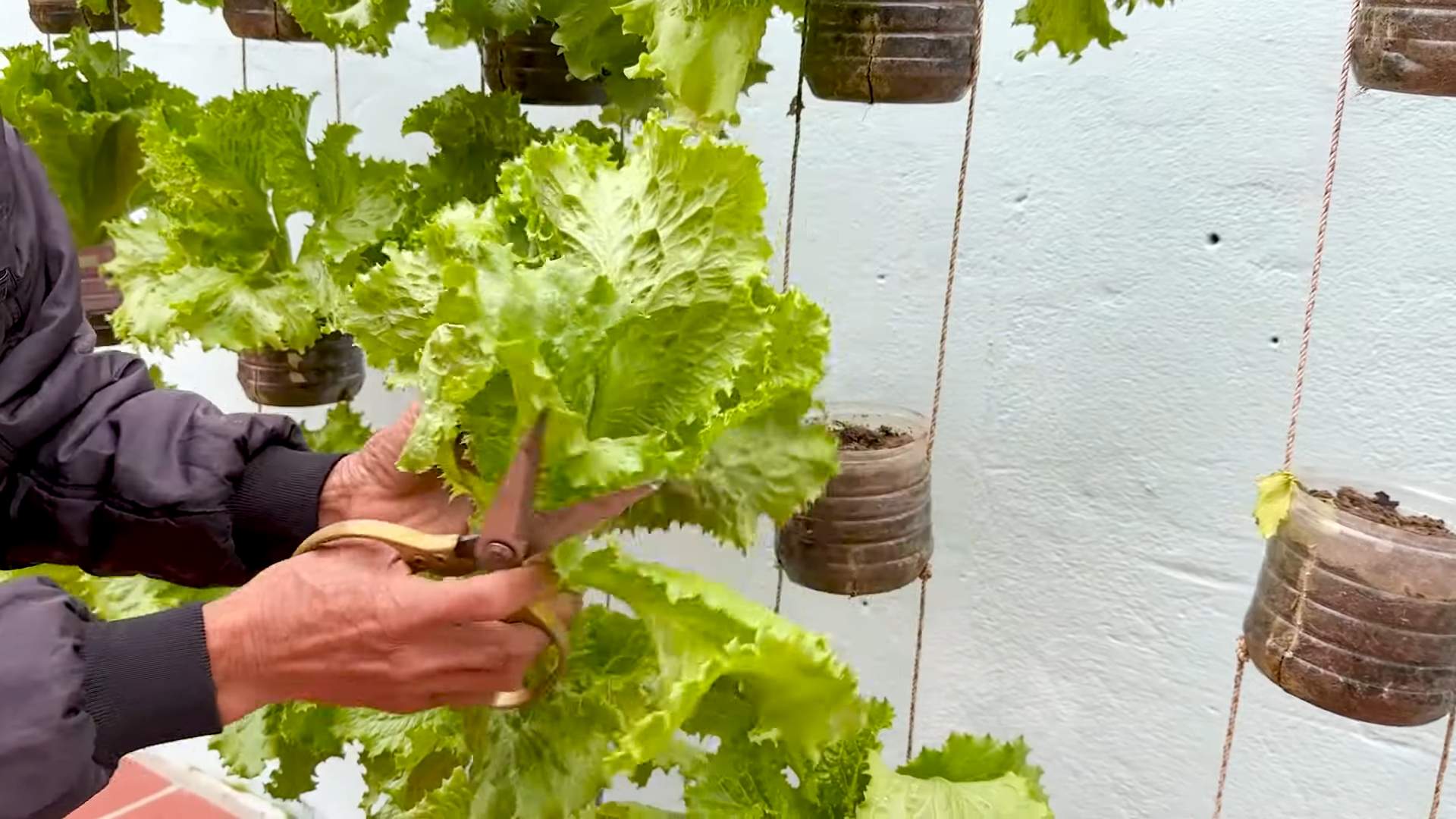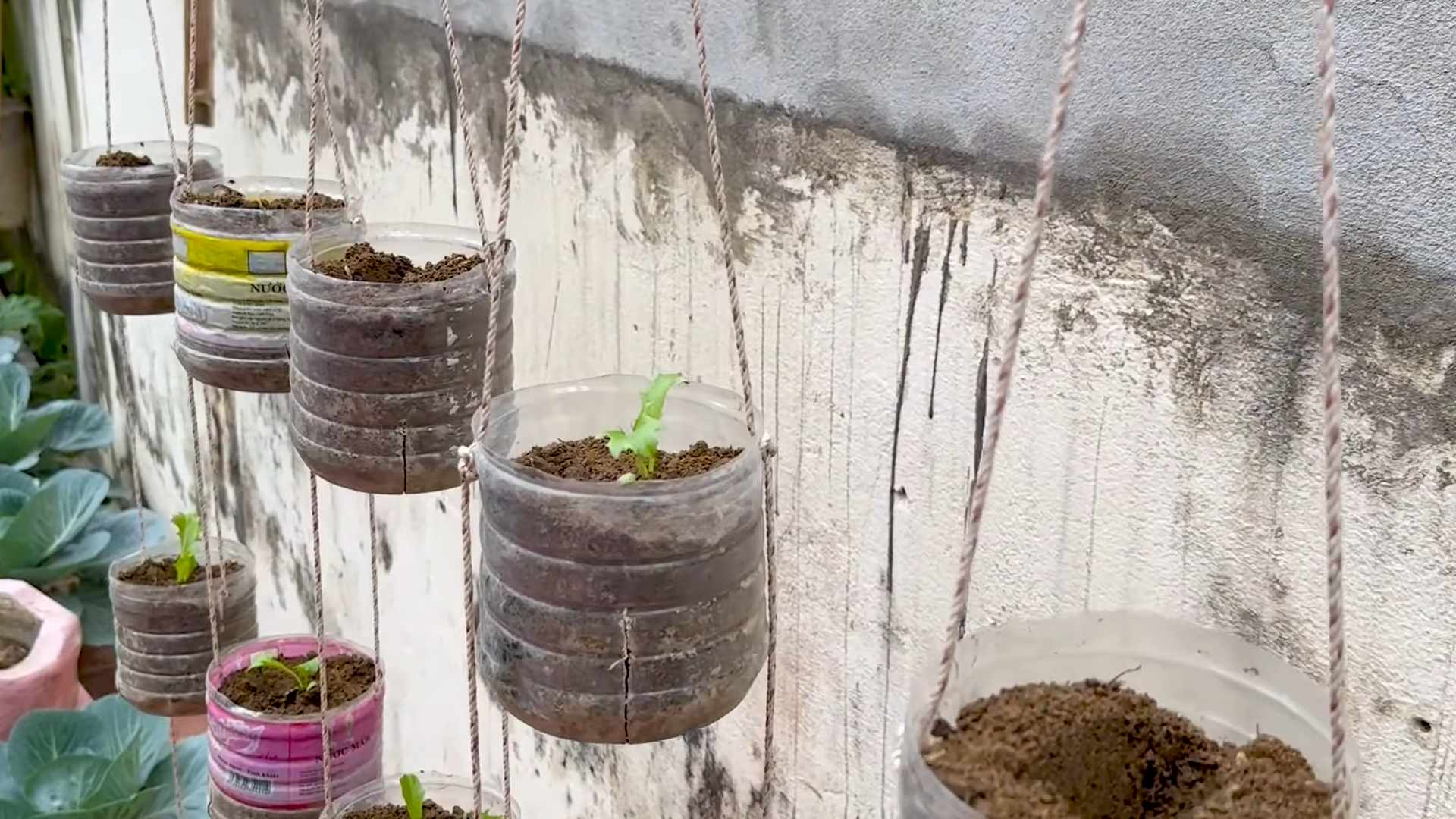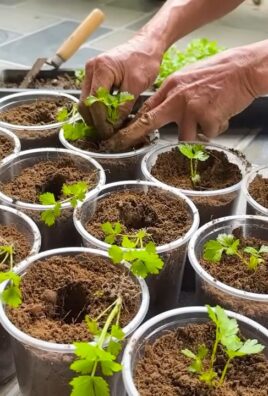Grow Fresh Lettuce right in your backyard, even if you think you don’t have a green thumb! Imagine stepping outside and harvesting crisp, vibrant lettuce for your salad, sandwich, or even a refreshing lettuce wrap. No more trips to the grocery store for wilted, overpriced greens. This isn’t just a dream; it’s an achievable reality with a few simple DIY tricks and hacks that I’m excited to share with you.
Lettuce cultivation has a rich history, dating back to ancient Egypt, where it was initially grown for its seeds and oil. Over time, the leafy greens became a staple in diets worldwide. Today, the demand for fresh, locally sourced produce is higher than ever, and what better way to meet that demand than by growing your own?
Many people are intimidated by the idea of gardening, believing it requires vast spaces, specialized equipment, or years of experience. But the truth is, growing your own lettuce can be incredibly easy and rewarding, even in small spaces like balconies or patios. I’m here to show you how to grow fresh lettuce successfully, saving you money, reducing your carbon footprint, and providing you with delicious, healthy greens all season long. Let’s dive in and unlock the secrets to a thriving lettuce patch!

Grow Your Own Salad Bowl: A Beginner’s Guide to Growing Lettuce at Home
Hey there, fellow gardening enthusiasts! Are you tired of buying wilted, overpriced lettuce from the grocery store? I know I was! That’s why I decided to take matters into my own hands and start growing my own. And guess what? It’s way easier than you might think! This guide will walk you through everything you need to know to have a constant supply of fresh, crisp lettuce right at your fingertips. Get ready to say goodbye to sad supermarket salads!
Choosing Your Lettuce Varieties
First things first, let’s talk lettuce types. There are so many delicious varieties to choose from, and the best part is, you can mix and match to create your perfect salad blend. Here are a few of my favorites:
* Romaine: This is your classic Caesar salad lettuce. It’s got a crisp texture and a slightly bitter flavor.
* Butterhead (Boston or Bibb): These are known for their soft, buttery leaves and mild flavor. They’re perfect for delicate salads.
* Loose-leaf: This is where you get the most variety! Think red leaf, green leaf, oak leaf – the possibilities are endless. They’re easy to grow and harvest, and they add a beautiful pop of color to your garden.
* Crisphead (Iceberg): Okay, I’ll admit, iceberg lettuce isn’t the most nutritious, but sometimes you just crave that satisfying crunch! It’s a bit more challenging to grow than other varieties, but definitely doable.
Pro Tip: Consider the climate in your area when choosing your lettuce varieties. Some are more heat-tolerant than others. Loose-leaf varieties generally handle warmer weather better than romaine or butterhead.
Getting Started: Seeds vs. Seedlings
You have two main options for starting your lettuce garden: seeds or seedlings. Both have their pros and cons.
* Seeds: Starting from seed is more economical, and you’ll have a wider selection of varieties to choose from. However, it requires a bit more patience and attention.
* Seedlings: Buying seedlings is a quicker and easier way to get started. You’ll skip the germination process and have a head start on your harvest. But, it can be more expensive, and your variety choices might be limited.
Personally, I like to start some of my lettuce from seed and buy a few seedlings to get a mix of varieties and a staggered harvest.
Preparing Your Growing Space
Lettuce is pretty adaptable, but it does have some preferences. Here’s what you need to consider when choosing a location for your lettuce garden:
* Sunlight: Lettuce needs at least 4-6 hours of sunlight per day. However, in hotter climates, it can benefit from some afternoon shade to prevent bolting (going to seed).
* Soil: Lettuce prefers well-drained, fertile soil with a pH between 6.0 and 7.0. If your soil is heavy clay or sandy, amend it with compost or other organic matter to improve drainage and fertility.
* Container vs. Garden Bed: Lettuce grows well in both containers and garden beds. If you’re short on space, containers are a great option. Just make sure they’re large enough to accommodate the mature size of your lettuce plants.
My Go-To Soil Mix: I like to use a mix of equal parts compost, potting soil, and perlite for my lettuce. This provides good drainage, aeration, and nutrients.
Planting Your Lettuce
Okay, now for the fun part – planting! Here’s how to plant your lettuce, whether you’re starting from seed or seedlings:
Planting from Seed:
1. Prepare the soil: Rake the soil smooth and remove any rocks or debris.
2. Sow the seeds: Sprinkle the seeds thinly over the soil surface. You can also sow them in rows, spacing them about 1 inch apart.
3. Cover the seeds: Lightly cover the seeds with about ¼ inch of soil.
4. Water gently: Water the soil gently to avoid washing away the seeds.
5. Keep the soil moist: Keep the soil consistently moist until the seeds germinate, which usually takes about 7-10 days.
6. Thin the seedlings: Once the seedlings have a few true leaves, thin them to about 6-8 inches apart. This will give them enough room to grow.
Planting Seedlings:
1. Prepare the soil: Dig a hole that’s slightly larger than the root ball of the seedling.
2. Remove the seedling from its container: Gently loosen the roots of the seedling before planting.
3. Place the seedling in the hole: Make sure the top of the root ball is level with the soil surface.
4. Fill in the hole: Fill in the hole with soil and gently firm it around the seedling.
5. Water thoroughly: Water the seedling thoroughly after planting.
6. Space the seedlings: Space the seedlings about 6-8 inches apart.
Caring for Your Lettuce
Lettuce is relatively low-maintenance, but there are a few things you can do to keep it happy and healthy:
* Watering: Water your lettuce regularly, especially during hot, dry weather. Aim to keep the soil consistently moist, but not waterlogged.
* Fertilizing: Lettuce is a light feeder, but it can benefit from a boost of nutrients. I like to use a liquid fertilizer diluted to half strength every few weeks.
* Weeding: Keep your lettuce patch free of weeds, which can compete for nutrients and water.
* Pest Control: Lettuce can be susceptible to pests like aphids, slugs, and snails. Check your plants regularly and take action if you see any signs of infestation. I prefer to use organic pest control methods, such as insecticidal soap or diatomaceous earth.
* Bolting Prevention: As I mentioned earlier, lettuce can bolt (go to seed) in hot weather. This makes the leaves bitter and unpalatable. To prevent bolting, provide your lettuce with some afternoon shade, water it regularly, and harvest it frequently.
My Watering Tip: Water your lettuce in the morning to give the leaves time to dry before nightfall. This will help prevent fungal diseases.
Harvesting Your Lettuce
The best part of growing your own lettuce is, of course, harvesting it! You can start harvesting lettuce as soon as the leaves are big enough to eat.
* Loose-leaf lettuce: You can harvest loose-leaf lettuce by simply snipping off the outer leaves as needed. This allows the plant to continue producing new leaves.
* Head lettuce: For head lettuce, wait until the head is firm and well-formed before harvesting. Cut the head off at the base of the plant.
Harvesting Tip: Harvest your lettuce in the morning, when the leaves are crisp and cool.
Extending Your Lettuce Season
Lettuce is a cool-season crop, which means it grows best in spring and fall. However, with a little planning, you can extend your lettuce season and enjoy fresh lettuce for a longer period of time.
* Succession Planting: Sow new lettuce seeds every few weeks to ensure a continuous harvest.
* Cold Frames or Greenhouses: Use cold frames or greenhouses to protect your lettuce from frost and extend the growing season into the winter.
* Heat-Tolerant Varieties: Choose heat-tolerant lettuce varieties for summer growing.
* Shade Cloth: Use shade cloth to protect your lettuce from the intense summer sun.
Troubleshooting Common Lettuce Problems
Even with the best care, you might encounter some problems when growing lettuce. Here are a few common issues and how to deal with them:
* Bolting: As mentioned earlier, bolting is when lettuce goes to seed. To prevent bolting, provide your lettuce with shade, water it regularly, and harvest it frequently.
* Aphids: Aphids are small, sap-sucking insects that can infest lettuce plants. To control aphids, spray your plants with insecticidal soap or neem oil.
* Slugs and Snails: Slugs and snails can damage lettuce leaves by chewing holes in them. To control slugs and snails, use slug bait or handpick them off the plants.
* Downy Mildew: Downy mildew is a fungal disease that can cause yellow spots on lettuce leaves. To prevent downy mildew, provide good air circulation and avoid overhead watering.
My Pest Control Secret: I swear by diatomaceous earth for controlling slugs, snails, and other crawling pests. It’s a natural, non-toxic powder that dehydrates the pests.
Enjoying Your Homegrown Lettuce
Now that you’ve grown your own lettuce, it’s time to enjoy the fruits (or rather, vegetables) of your labor! There are endless ways to use your fresh lettuce. Here are a few of my favorites:
* Salads: Of course! Use your

Conclusion
So, there you have it! Growing your own fresh lettuce at home is not only achievable, but it’s also incredibly rewarding. Forget those limp, pre-packaged greens from the grocery store. Imagine stepping out into your garden, balcony, or even just your windowsill, and harvesting crisp, vibrant lettuce leaves whenever you need them. The difference in taste and texture is simply unparalleled. This DIY approach offers a level of freshness and control over your food that you just can’t get any other way.
Why is this DIY trick a must-try? Because it empowers you to take control of your food source, reduces your reliance on store-bought produce (and the associated environmental impact), and provides you with the freshest, most flavorful lettuce imaginable. Plus, it’s a fantastic way to connect with nature and learn more about the growing process.
But the beauty of growing your own lettuce doesn’t stop there. The possibilities for customization are endless! Experiment with different varieties of lettuce to find your favorites. Try growing loose-leaf varieties like Black Seeded Simpson or Oakleaf for continuous harvesting, or opt for head lettuce like Romaine or Butterhead for a more substantial yield. You can even mix and match different types in the same container for a colorful and diverse salad blend.
Consider adding companion plants to your lettuce patch to deter pests and improve growth. Marigolds, for example, are known to repel nematodes and other harmful insects. Herbs like basil and mint can also enhance the flavor of your lettuce and attract beneficial pollinators.
For those with limited space, vertical gardening is an excellent option. Use stacked planters or hanging baskets to maximize your growing area and create a stunning visual display. You can also try growing lettuce indoors under grow lights, especially during the colder months, to enjoy fresh greens year-round.
Don’t be afraid to experiment with different soil mixes and fertilizers to find what works best for your growing conditions. Organic fertilizers, such as compost tea or worm castings, are a great way to nourish your lettuce plants and promote healthy growth.
We wholeheartedly encourage you to give this DIY trick a try. It’s easier than you might think, and the rewards are well worth the effort. Once you’ve tasted the difference between homegrown lettuce and store-bought lettuce, you’ll never go back.
And most importantly, we want to hear about your experience! Share your tips, tricks, and photos with us in the comments below. Let us know what varieties of lettuce you’re growing, what challenges you’ve encountered, and what successes you’ve celebrated. Together, we can create a community of passionate gardeners who are dedicated to growing their own fresh, delicious lettuce. So, get your hands dirty and start growing today! You’ll be amazed at how easy and rewarding it is to grow fresh lettuce right in your own home.
Frequently Asked Questions (FAQ)
What is the best time of year to plant lettuce?
Lettuce is a cool-season crop, meaning it thrives in temperatures between 60°F and 70°F (15°C and 21°C). The best time to plant lettuce is in early spring or late summer/early fall. In warmer climates, you can grow lettuce throughout the winter. Avoid planting lettuce during the hottest months of summer, as high temperatures can cause it to bolt (go to seed), resulting in bitter-tasting leaves. If you live in an area with hot summers, consider planting lettuce in a shady spot or using shade cloth to protect it from the intense sun.
What kind of soil is best for growing lettuce?
Lettuce prefers well-drained, fertile soil that is rich in organic matter. The ideal soil pH for lettuce is between 6.0 and 7.0. Before planting, amend your soil with compost, aged manure, or other organic materials to improve its fertility and drainage. If your soil is heavy clay, consider adding sand or perlite to improve drainage. You can also grow lettuce in raised beds or containers filled with a high-quality potting mix.
How much sunlight does lettuce need?
Lettuce needs at least six hours of sunlight per day to grow well. However, in hot climates, lettuce can benefit from some afternoon shade. If you’re growing lettuce indoors, place it near a sunny window or use grow lights to provide adequate light. Rotate your lettuce plants regularly to ensure that all sides receive equal light exposure.
How often should I water lettuce?
Lettuce needs consistent moisture to thrive. Water your lettuce plants regularly, especially during hot, dry weather. Aim to keep the soil consistently moist but not waterlogged. Water deeply and less frequently, rather than shallowly and more often, to encourage deep root growth. Avoid overhead watering, as this can lead to fungal diseases. Use a soaker hose or drip irrigation system to water your lettuce plants at the base.
How do I harvest lettuce?
The harvesting method depends on the type of lettuce you are growing. For loose-leaf lettuce, you can harvest individual leaves as needed, starting with the outer leaves. Simply snip off the leaves with scissors or gently pull them off the plant. For head lettuce, wait until the head is firm and well-formed before harvesting. Cut the head off at the base with a sharp knife.
How do I prevent lettuce from bolting?
Bolting is a common problem with lettuce, especially during hot weather. To prevent bolting, choose bolt-resistant varieties of lettuce, plant lettuce in a shady spot, and water regularly to keep the soil cool and moist. You can also use shade cloth to protect your lettuce plants from the intense sun. Harvest lettuce regularly to encourage continued leaf production and delay bolting.
What are some common pests and diseases that affect lettuce?
Some common pests that affect lettuce include aphids, slugs, snails, and cutworms. To control these pests, you can use organic pest control methods such as hand-picking, insecticidal soap, or diatomaceous earth. Common diseases that affect lettuce include downy mildew, powdery mildew, and leaf spot. To prevent these diseases, ensure good air circulation around your lettuce plants, avoid overhead watering, and remove any infected leaves promptly.
Can I grow lettuce in containers?
Yes, lettuce grows very well in containers. Choose a container that is at least 6 inches deep and has drainage holes. Fill the container with a high-quality potting mix and plant your lettuce seeds or seedlings. Place the container in a sunny location and water regularly. Container-grown lettuce may need more frequent watering than lettuce grown in the ground.
How long does it take for lettuce to grow?
The time it takes for lettuce to grow depends on the variety and growing conditions. Loose-leaf lettuce can be harvested in as little as 30 days, while head lettuce may take 60-80 days to mature. Check the seed packet or plant tag for specific information on the maturity time for your chosen variety.
What are some good companion plants for lettuce?
Good companion plants for lettuce include carrots, radishes, onions, garlic, and marigolds. Carrots and radishes help to loosen the soil around lettuce roots, while onions and garlic deter pests. Marigolds are known to repel nematodes and other harmful insects. Avoid planting lettuce near fennel, as it can inhibit lettuce growth.




Leave a Comment